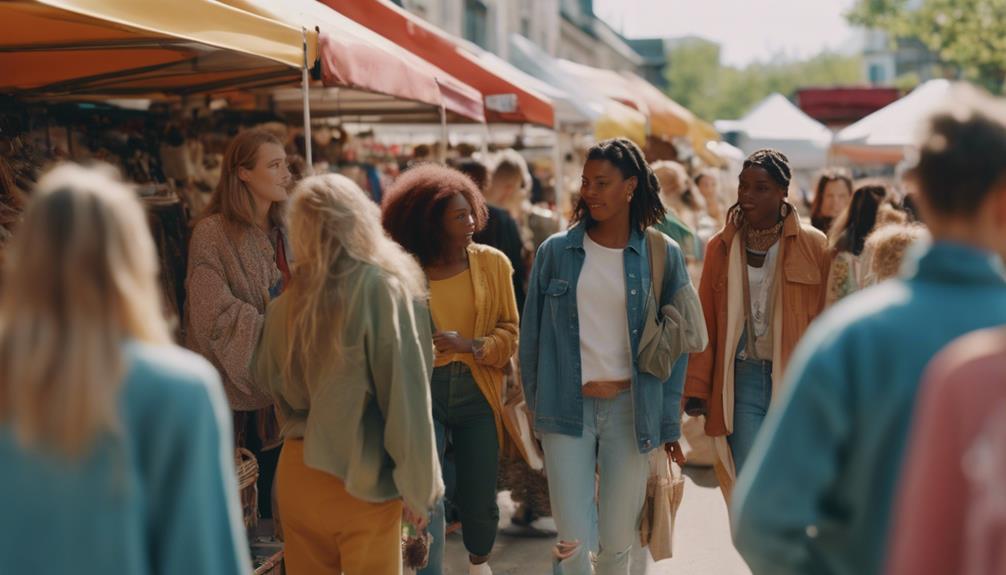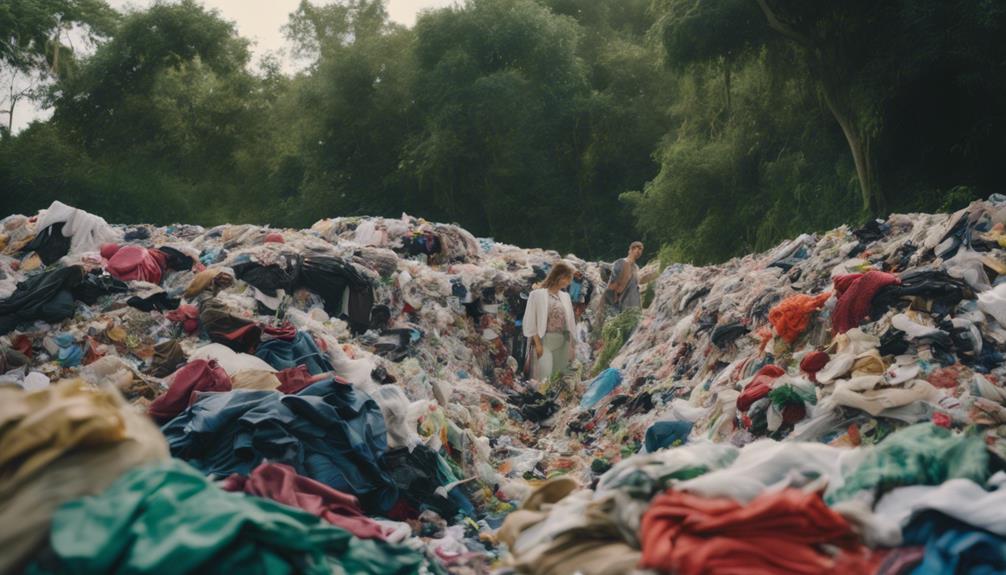You have the ability to create a significant impact on sustainable fashion by valuing quality over quantity when selecting items for your wardrobe. Consider exploring thrift shops or organizing clothing swaps as ways to reduce textile waste and save money. Look for brands that use sustainable materials, such as organic cotton or recycled polyester, and prioritize ethical labor practices. Embrace natural dyes and endorse eco-friendly packaging options to cut down on waste. Constructing a capsule wardrobe with versatile pieces can not only simplify your style but also reduce your carbon footprint. By incorporating these practices, you are contributing to a more sustainable and brighter future for the fashion industry—there is so much more to discover!
Key Takeaways
- Embrace thrift shopping to reduce textile waste and save money while finding unique fashion pieces that benefit local charities.
- Build a capsule wardrobe with 20-30 high-quality versatile items to minimize reliance on fast fashion and extend garment lifespans.
- Support brands that prioritize ethical labor practices and transparency in their sourcing to promote fair treatment for workers in the fashion industry.
- Participate in clothing swaps to extend garment lifecycles, promote community engagement, and combat the demand for new production.
Importance of Sustainable Fashion
Sustainable fashion is crucial for protecting our planet and promoting ethical practices in an industry that greatly impacts the environment. The fashion industry contributes to a staggering 10% of annual global carbon emissions, and it's projected to produce 148 million tons of waste by 2030. This alarming environmental impact highlights the urgent need for a shift towards sustainable fashion.
By choosing quality over quantity, you can help reduce the demand for fast fashion, which sees 60% of clothing discarded within a year. Investing in sustainable fashion not only decreases waste but also supports ethical fashion. Many sustainable brands prioritize fair wages and safe working conditions for their workers, ensuring that your purchases contribute to a more just industry.
As more consumers, particularly millennials, recognize the importance of sustainability—71% now prioritize it in their shopping choices—you have the power to drive change. By opting for sustainable brands and practices, you can play an active role in reducing pollution and waste. Embracing sustainable fashion isn't just a trend; it's a crucial step towards a healthier planet and a more equitable fashion industry.
Sustainable Materials to Consider

Choosing the right materials can make a significant difference in reducing your environmental footprint in fashion. By opting for sustainable materials, you can help the planet while looking stylish. Here are some top choices to contemplate:
- Organic Cotton: Grown without harmful pesticides, it uses 91% less water during cultivation.
- Recycled Polyester: This material can cut energy consumption by up to 99% compared to new fibers.
- Natural Fibers: Consider linen, hemp, or bamboo, which break down easily and minimize waste.
- Recycled Materials: Incorporating recycled content helps reduce overall environmental impact and promotes a circular economy.
Water Conservation Techniques

Implementing effective water conservation techniques in fashion production can dramatically reduce your environmental impact. One way to contribute is by opting for water-efficient fabrics, like those made from recycled materials or organic cotton. These choices help minimize the water footprint associated with garment manufacturing.
Another vital method is the adoption of closed-loop water systems, which allow for recycling and reusing water in production processes. This not only conserves precious resources but can save millions of gallons annually, greatly enhancing sustainable practices in the industry.
As a consumer, you can play a pivotal role by educating yourself and others about the importance of water conservation in fashion. This awareness leads to more mindful purchasing decisions and helps reduce the demand for water-intensive products.
Moreover, advocating for brands that monitor their water usage and set reduction targets can drive considerable improvements in water conservation efforts. By supporting such initiatives, you contribute to addressing global water scarcity issues while promoting sustainable practices in fashion.
Together, we can make a difference and encourage the industry to prioritize water conservation.
Embracing Natural Dyes

Embracing natural dyes not only reduces harmful pollution but also adds unique character to your wardrobe. By choosing fabrics dyed with natural ingredients, you support sustainable brands that prioritize the environment and promote ethical practices.
Here are some reasons to reflect on incorporating natural dyes into your fashion choices:
- Reduced Chemical Runoff: Natural dyes come from plants and minerals, greatly lowering the environmental impact compared to synthetic dyes.
- Unique Color Variations: Each piece dyed with natural ingredients exhibits distinct colors and textures, enhancing your individuality.
- Water Efficiency: The production of natural dyes generally uses less water, which is essential in areas facing water scarcity.
- Cultural Preservation: Utilizing traditional dyeing techniques helps revive craftsmanship and preserves cultural heritage in the textile industry.
Reducing Fashion Waste

Reducing fashion waste starts with simple choices you can make every day.
Consider embracing thrift shopping to find unique pieces while keeping clothes out of landfills.
Embrace Thrift Shopping
Thrift shopping not only helps you save money but also plays an essential role in cutting down fashion waste and promoting a sustainable wardrobe. By choosing second-hand clothing, you contribute to a more eco-friendly fashion industry. Here are some compelling reasons to embrace thrift shopping:
- Reduce Waste: Every piece you buy from thrift stores helps prevent textile waste from ending up in landfills—over 13 million tons are saved annually!
- Save Money: You can save around 50-70% on your fashion costs, allowing you to spend less while still looking stylish.
- Unique Finds: Thrift stores often have unique, high-quality pieces that add character to your sustainable wardrobe.
- Support Local Communities: Many thrift stores donate proceeds to local charities, benefiting your community while you shop.
With each visit to a thrift store, you're not just shopping; you're making a positive impact on the environment and your community.
Prioritize Quality Over Quantity
Choosing high-quality garments instead of fast fashion items can dramatically cut down on clothing waste and promote a more sustainable wardrobe.
When you invest in quality pieces, you're not only extending their lifespan but also reducing your environmental impact. Just by keeping your clothing for an extra nine months, you can decrease your carbon footprint by 30%.
Fast fashion contributes considerably to the fashion industry's 10% share of global carbon emissions. Low-quality clothing typically ends up in landfills after just a few wears, worsening this statistic.
Currently, less than 1% of clothing materials are recycled, highlighting the need for durable items that can be reused or repaired.
Participate in Clothing Swaps
Participating in clothing swaps offers a fun and eco-friendly way to refresh your wardrobe while minimizing fashion waste. By swapping gently used garments, you not only save money but also help reduce your environmental impact.
Here are some benefits of joining clothing swaps:
- Extend Clothing Lifecycles: Keep garments in circulation, reducing the demand for new production.
- Build Community: Foster connections with like-minded individuals focused on sustainable practices.
- Discover Unique Styles: Find one-of-a-kind pieces that stand out from traditional retail offerings.
- Combat Fast Fashion: Save money and avoid the financial strain of constantly replacing clothes.
Engaging in clothing swaps is a fantastic way to actively participate in sustainable practices while enjoying a unique shopping experience.
As the fashion industry is projected to generate 148 million tons of waste by 2030, every small action counts. So gather your friends, organize a swap, and get creative with your wardrobe!
Supporting Ethical Labor Practices
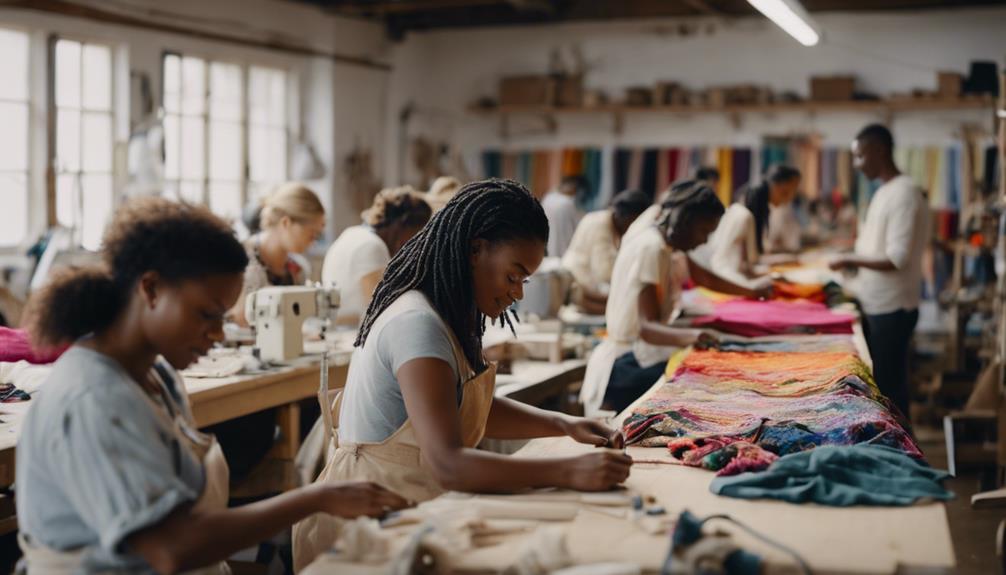
Support ethical labor practices by opting for brands that prioritize fair wages and safe working conditions for their employees. The fashion industry often exploits cheap labor, particularly in developing countries, making your choice essential.
By purchasing from brands committed to ethical and sustainable practices, you can help guarantee that workers aren't trapped in modern slavery—approximately 40 million people currently are.
Look for companies that conduct regular audits of their manufacturing processes. These audits help maintain compliance with ethical standards and safeguard the welfare of employees. When you choose brands that promote transparency and accountability in their supply chains, you're driving demand for better labor practices across the industry.
Additionally, consider supporting local artisans and manufacturers. This not only empowers communities but also reduces the environmental footprint associated with long-distance transportation of goods.
Eco-Friendly Packaging Solutions

When it comes to eco-friendly packaging, you've got some great options.
Using recycled materials or biodegradable choices can really cut down on waste and environmental harm.
Plus, embracing minimalist packaging design not only helps the planet but can also enhance your brand's appeal.
Recycled Material Packaging
Recycled material packaging offers a smart solution for brands looking to reduce waste and lower their carbon footprint while appealing to eco-conscious consumers. By choosing packaging made from recycled materials, you're not just supporting sustainable development; you're also encouraging companies to adopt greener practices.
Here are some ways recycled packaging makes a difference:
- Energy Efficiency: Recycled materials require less energy to process than virgin materials, cutting down on emissions.
- Innovative Designs: Smart packaging designs minimize material use, leading to smaller sizes that reduce waste and transportation emissions.
- Take-Back Programs: Many brands offer take-back programs for used packaging, promoting recycling and a circular economy.
- Consumer Education: Educating yourself and others on proper disposal methods enhances the effectiveness of eco-friendly packaging solutions.
Biodegradable Options Availability
Exploring biodegradable packaging options can greatly reduce your environmental impact while keeping products safe and fresh. These eco-friendly alternatives, made from materials like cornstarch and sugarcane, decompose naturally within months, unlike traditional plastics that can linger for centuries. By choosing biodegradable packaging, you're not just opting for a trend; you're actively promoting sustainability.
| Material Type | Decomposition Time | Carbon Emission Reduction |
|---|---|---|
| Cornstarch | 3-6 months | 30% |
| Sugarcane | 2-4 months | 30% |
| Mushroom Packaging | 30-90 days | 30% |
Many brands are now shifting towards biodegradable options, with 50% of consumers preferring these over traditional plastics. This choice not only enhances your shopping experience but also supports brands prioritizing sustainability. Plus, studies show that 74% of consumers are more likely to buy from companies that focus on eco-friendly packaging. So, the next time you're shopping, consider the environmental impact of your choices and opt for biodegradable packaging whenever possible.
Minimalist Packaging Design
Minimalist packaging design emphasizes simplicity and functionality, ensuring that every element serves a purpose while minimizing waste.
When you choose eco-friendly packaging, you not only enhance your style but also actively help reduce your environmental impact. Here are some key aspects to reflect on:
- Use recycled or biodegradable materials: This greatly cuts down on the plastic waste that's piling up globally.
- Optimize package size: Smaller packages consume less material and reduce transportation emissions, making shipping more efficient.
- Participate in take-back programs: Returning used packaging for recycling promotes a circular economy and lessens landfill contributions.
- Educate yourself on disposal: Knowing how to properly recycle packaging can increase recycling rates, as many consumers are willing to recycle if given clear instructions.
Embracing minimalist packaging design not only benefits the planet but can also set you apart in a crowded fashion market.
Make conscious choices and watch your impact grow!
Innovations in Sustainable Fashion
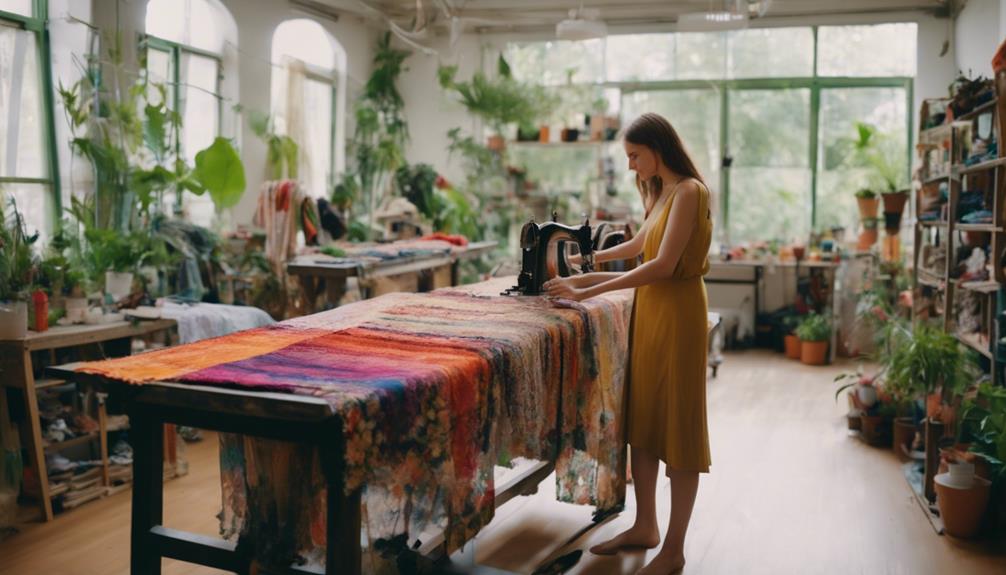
As the fashion industry evolves, innovative materials and technologies are transforming how we create and consume clothing sustainably. Many brands are leading the charge with groundbreaking innovations.
For instance, Patagonia has pioneered the use of polyester fleece made from recycled plastic bottles, considerably cutting down on waste. You might also want to explore alternatives like Tencel, sourced from sustainably harvested wood pulp, which uses less water and fewer chemicals than traditional cotton.
3D knitting technology is another exciting development. This method allows brands to produce garments directly from digital patterns, reducing fabric waste through on-demand manufacturing.
If you're concerned about animal products, consider bio-fabricated materials like mycelium leather, derived from mushrooms, which presents a sustainable alternative to conventional leather.
Lastly, take note of recycled cotton processes that can slash water usage by up to 90% compared to conventional cotton farming.
These innovations not only make fashion more sustainable but also encourage you to make mindful choices. By supporting brands that prioritize these advancements, you contribute to a more sustainable fashion future.
Community Engagement Initiatives
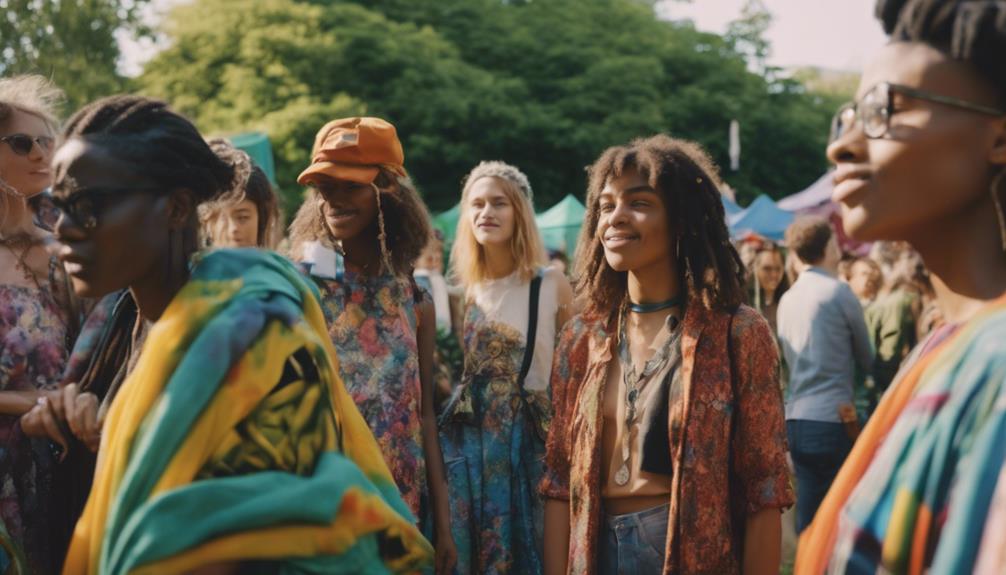
Getting involved in community engagement initiatives can transform your approach to sustainable fashion.
By organizing clothing swaps, collaborating with local artisans, and participating in community clean-up events, you not only reduce waste but also strengthen your local economy and environment.
These activities foster connections and create awareness about the impact of fashion on our world.
Clothing Swaps Benefits
How can clothing swaps enhance community bonds while promoting sustainable fashion practices?
By participating in clothing swaps, you not only refresh your wardrobe but also contribute to a positive impact on your community and the environment. These events foster connections among neighbors and friends while combating the fast fashion industry's waste problem.
Here are some benefits of clothing swaps:
- Strengthened community ties: You'll meet new people and build friendships over shared interests.
- Cost-effective fashion: Save up to 90% on clothing costs compared to buying new items.
- Reduced waste: Swapping helps decrease the amount of clothing sent to landfills, promoting a culture of reuse.
- Unique finds: Discover one-of-a-kind pieces that reflect your personal style.
Local Artisan Collaborations
Partnering with local artisans not only enriches your wardrobe but also strengthens community ties and promotes sustainable practices. By choosing to support local artisans, you're investing in unique craftsmanship that reflects cultural heritage. Each piece you buy tells a story, making your fashion choices more meaningful and sustainable.
Working with local artisans greatly cuts down on transportation emissions since these goods don't need to travel far, unlike mass-produced items sourced from overseas. This reduction in shipping helps lower carbon footprints, aligning with your commitment to sustainability. Plus, local artisans often embrace eco-friendly materials and traditional techniques, ensuring ethical production practices that benefit the environment.
Participating in community engagement initiatives, such as artisan markets or pop-up shops, gives you direct access to sustainable fashion options. These events encourage mindful consumption, allowing you to consciously choose alternatives to fast fashion. Every purchase helps sustain local livelihoods and strengthens the local economy, fostering a sense of community.
Community Clean-Up Events
Community clean-up events not only beautify local spaces but also create a sense of unity among residents committed to sustainability. By participating, you can actively combat the environmental impacts of fast fashion while fostering community bonds. These initiatives do more than just tidy up; they raise awareness about the staggering amount of textile waste generated each year.
Here are some benefits of joining community clean-up events:
- Enhance local environments: Remove litter and debris, making your area more inviting.
- Build connections: Meet like-minded individuals who share your passion for sustainability.
- Increase awareness: Learn about the environmental effects of fast fashion and effective waste reduction strategies.
- Encourage collective action: Inspire others in your community to engage in sustainability initiatives.
When you get involved in community clean-up events, you're not just cleaning up; you're contributing to a larger movement towards sustainable living and responsible consumption. It's a win-win for you, your community, and the planet!
Building a Capsule Wardrobe
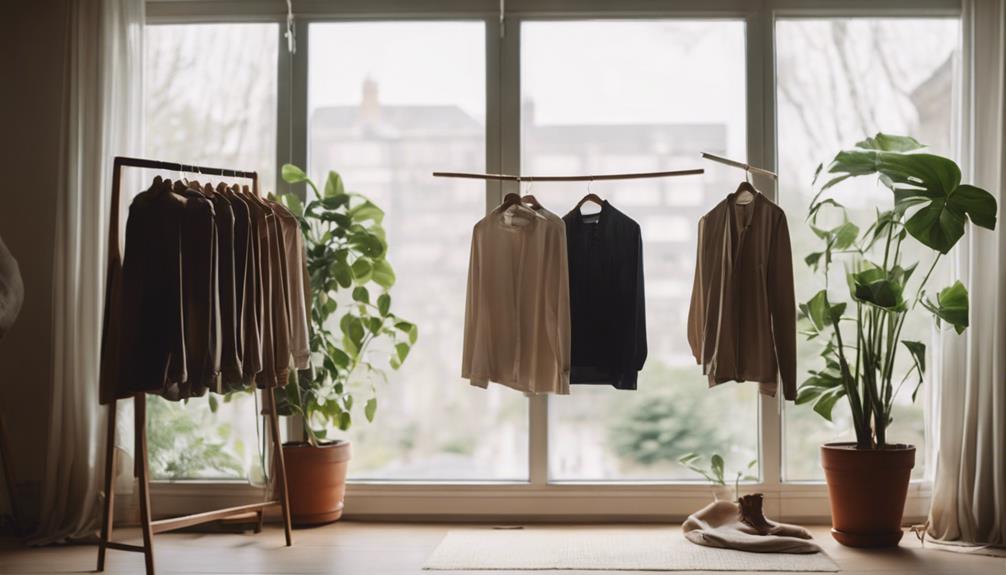
Building a capsule wardrobe helps you create a streamlined collection of versatile pieces that can be effortlessly mixed and matched for countless outfits. This approach typically includes 20-30 items, focusing on quality over quantity. By investing in timeless pieces, you extend the lifespan of your wardrobe, which is essential for adopting a sustainable lifestyle.
Here's a quick comparison to illustrate the benefits:
| Capsule Wardrobe | Traditional Wardrobe |
|---|---|
| 20-30 versatile pieces | 100+ impulse buys |
| Encourages mindful consumption | Often leads to waste |
| Reduces environmental impact | Higher carbon footprint |
Embracing a capsule wardrobe reduces reliance on fast fashion. Extending the use of clothing by just nine months can lower your carbon, water, and waste footprints by up to 30%. This mindful consumption not only simplifies your daily outfit choices but also fosters a culture of reuse. By thoughtfully considering each purchase, you can create a wardrobe that not only meets your style needs but also aligns with your values for sustainability.
Frequently Asked Questions
How Can Fashion Consumers Be More Sustainable?
To be more sustainable in fashion, you can shop second-hand, prioritize ethical brands, embrace clothing swaps, invest in quality pieces, and educate yourself on sustainable practices. Each choice helps reduce waste and supports a healthier planet.
How Can the Fashion Industry Be More Environmentally Sustainable?
Imagine a world where fashion cares for the planet. You can push brands to adopt renewable energy, utilize sustainable materials, and optimize shipping routes, all while advocating for zero-waste design and natural dyes in production.
What Can Consumers Do to Reduce Fast Fashion?
To reduce fast fashion, you can shop second-hand, participate in clothing swaps, rent outfits, and embrace mindful consumption. Investing in quality pieces and rediscovering items in your closet also helps lower your fashion footprint.
Why Are Consumers Becoming More Sustainable?
With 71% of millennials prioritizing sustainability, you're witnessing a shift in shopping habits. You realize the fashion industry's 10% carbon emissions impact and seek eco-friendly choices, driving a collective movement toward more responsible consumption.
What Are Some Small, Sustainable Fashion Choices Consumers Can Make?
When it comes to navigating life’s tiny pitfalls, consumers can make small, sustainable fashion choices to make a positive impact. Opting for second-hand clothing, supporting ethical brands, and investing in timeless pieces are all great ways to reduce environmental impact and promote sustainability in the fashion industry.
Conclusion
By embracing sustainable fashion, you're not just making a difference; you're becoming a superhero for the planet!
Every small change, from choosing eco-friendly materials to building a capsule wardrobe, adds up to create a monumental impact.
You have the power to revolutionize the industry and inspire others to join the movement.
So, let's shop wisely, reduce waste, and celebrate our unique style while protecting our beautiful Earth.
Together, we can change the fashion world for the better!
